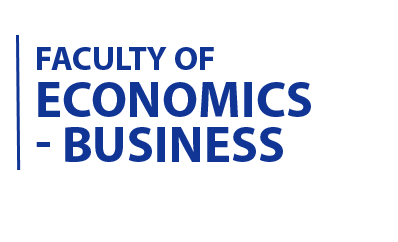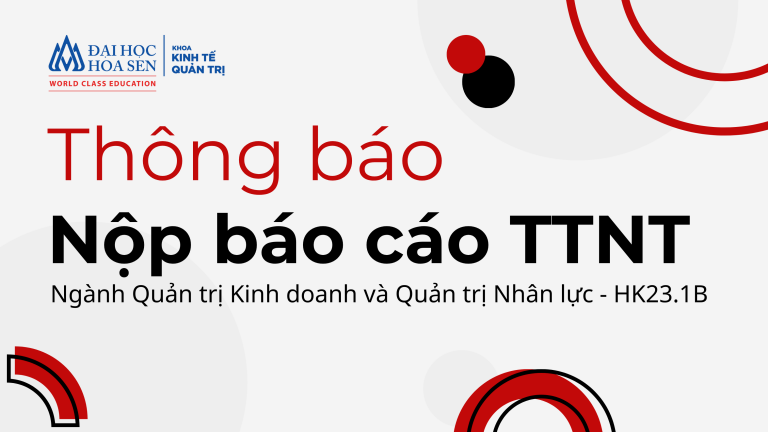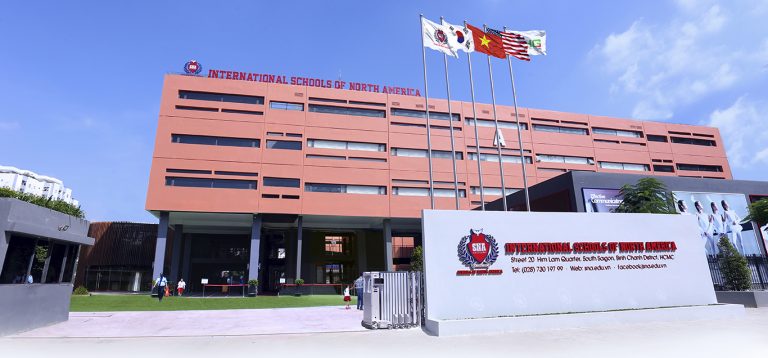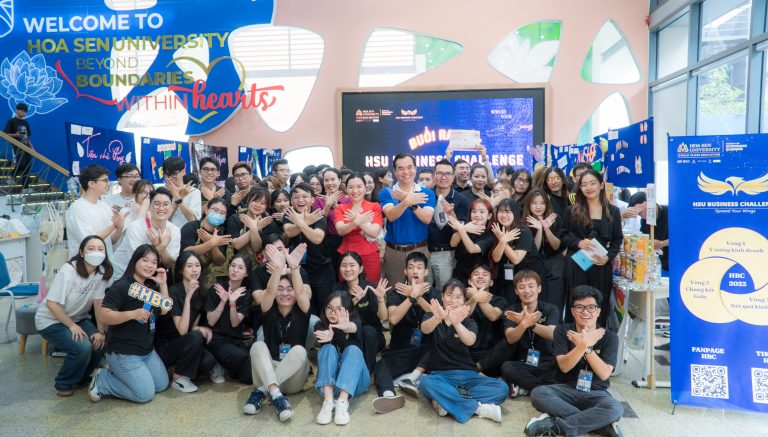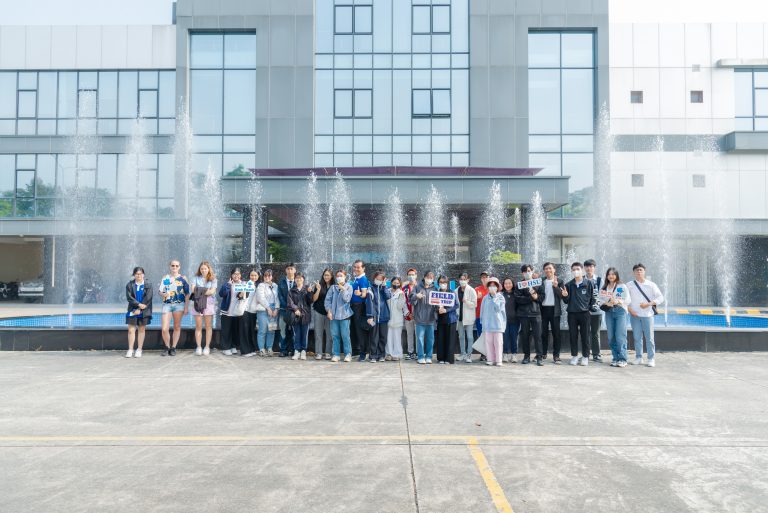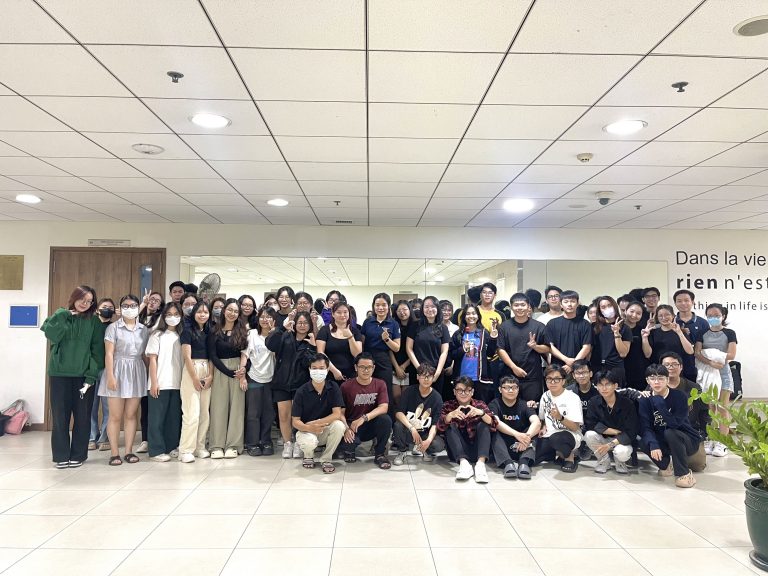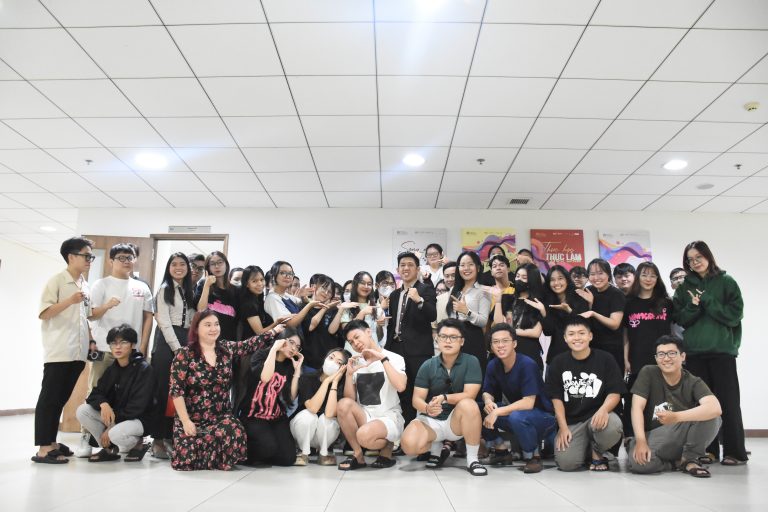TOPIC 04: COMPETING FOR THE IMPACT OF THE US-CHINA ECONOMY IN SOUTHEAST ASIA AND VIETNAM’S POLICY
COMPETING FOR THE IMPACT OF THE US-CHINA ECONOMY IN SOUTHEAST ASIA AND VIETNAM’S POLICY
SUMMARY
In modern world history, Southeast Asia has always been one of the regions of strategic geopolitical significance in the foreign policy of both the United States and China. By analyzing data of direct investment (FDI), two-way import and export value between the USA, PRC, and Southeast Asian countries, having an overview of bilateral trade cooperation mechanisms between the US and China Southeast Asian countries and countries, regional, continental, and global multilateral economic cooperation mechanisms, and having a brief overview of economic megaprojects that have an impact on Southeast Asia’s geo-economic and geopolitical changes in The United States and China, the research team hope to contribute to clarifying the competitive image of US-China economic influence in Southeast Asia today, and at the same time give recommendations for Vietnam’s countermeasures in the face of economic influence from the United States and China.
1. Opening
Power is a central concept in international relations theory because of “the ability to cause other actors to behave in the desired direction” (Payne, 2013, p.25), which is the goal of the government and the managers, is a condition to ensure security and is an affirmation of the country’s influence and position on the international political map. Hard power is characterized by intimidation and coercion through military force, economic pressure, and retribution (Mearsheimer, Campbell & O’Hanlon, 2006; Wilson, 2008).
The economy is considered an important factor that creates the hard power of a country, the relationship between investment and aid activities, the dispersion of capital, and the influence on another country is the ratio mutually agreeable (Viotti & Kauppi, 2013). Facing the trend of globalization, Ahmed (1995) recognized that economic interests play an increasingly vital role in international relations, with the same angle, Spyros Economides & Wilson (2001) in the book “Economic factors in international relations” argues that a country’s foreign policy is increasingly driven by commercial considerations and that economic power actually exerts more influence than military power because of its dependence on military power. The dependencies, connections, and interactions between economies are clear today.
The strategic dispute in Southeast Asia will become increasingly hot both in reality and at the diplomatic table. From that reality, it is necessary to examine the economic presence of the United States and PRC in Southeast Asia to contribute to clarifying the economic presence of the USA and PRC in Southeast Asia.
With the goal of assessing the influence of the USA and PRC from an economic perspective, the author builds a research model as shown in Figure 1, USA and PRC will be analyzed and compared based on the context of bringing economic benefits to 11 countries. Southeast Asian countries (country X) are Brunei, Cambodia, Indonesia, Laos, Malaysia, Myanmar, Philippines, Singapore, Thailand, Timor Leste, and Vietnam. According to the theory of new realism, the USA and PRC economies give away in return for the recognition of country X’s influence, the greater the economic benefits, the greater the influence, assuming other factors to another power do not affect this research model.
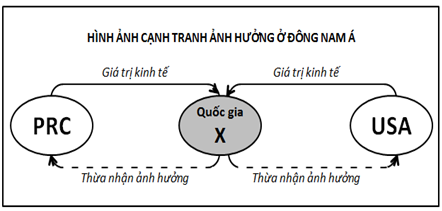
Bilateral economic relations between two countries are often considered with three pillars of economic cooperation, trade, and investment with observed variables such as foreign direct investment (FDI). , foreign indirect investment (FII), export and import turnover, the balance of trade, international aid, international agreements bilateral trade agreements. Multilateral economic relations between many countries are determined on the basis of international organizations, financial cooperation mechanisms, and economic and trade agreements with the participation of three or more countries. Within the scope of this report, the author focuses on analyzing the current situation and discussing research on the economic presence of the USA and PRC in Southeast Asia based on data collected on (1) direct investment flows (FDI), (2) export value (3) import between the USA, PRC and Southeast Asian countries, (4) bilateral and (5) multilateral economic cooperation mechanisms.
2. Research results
Direct investment (FDI) flows are investments in the form of ownership and control of enterprises (OECD, 2020), FDI has a positive impact on the economic development of countries with developing economies (Sarkodie & Strezov, 2019), while creating stable and lasting links between economies (OECD, 2020). FDI is the first indicator surveyed by the research author to clarify the participation of the USA and PRC in mergers and acquisitions, building new facilities, and reinvesting profits earned from operations in other Southeast Asian countries.
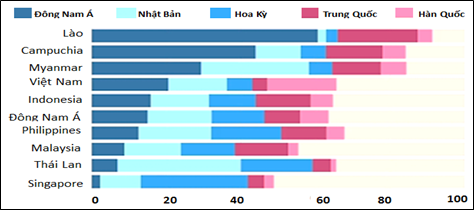
A statistic on FDI into Southeast Asia in Figure 3 shows that between 2003 and 2017, the USA invested $182 billion in Southeast Asia. PRC has invested $123 billion mainly focused on metals. Japan was the strongest FDI investor in Southeast Asia in the period 2003-2017.
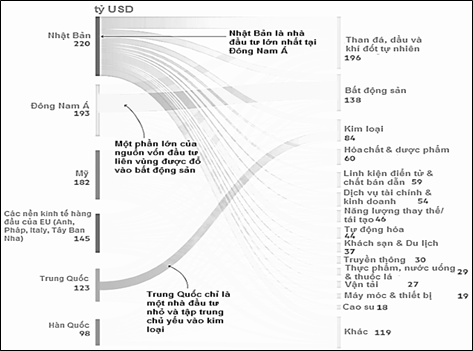
The value of exports and imports also reflects a country’s power and position in the international arena (Hausmann & Rodrik, 2006; Easterly et al., 2009). Exporting is the process of selling goods or services from one country to another and earning a foreign currency surplus (Joshi, 2005; Baldwin & Harrigan, 2007). Import is understood as the purchase of goods or services from another country, import allows a country to obtain products or services that it does not have or is scarce, high cost, or low quality from other countries (Lequiller & Blades, 2006; Baldwin & Harrigan, 2007).
Table 2. Comparison of import and export values between Southeast Asian countries

Source: Author’s synthesis of the data of the countries
In international economic relations, the export and import concentration in one country, in addition to the positive aspects pointed out above also reflects an economic dependence on the market and supply. The country that is the main market or the main source of imports is considered to have the power to influence the partner country.
Table 2 provides statistical data on the export value of Southeast Asian countries to the PRC and USA markets and the value of imports of goods and services from the PRC and the USA of the Southeast Asian countries in 2018. Price observations Export value of Southeast Asian countries to the PRC market, we find that for Indonesia, Laos, Myanmar, Singapore, and Thailand, PRC is the most important export market and the USA is the most important export market of Cambodia, the Philippines, and Vietnam. Observing the value of imports from the PRC and USA of Southeast Asian countries, it is found that PRC is the most important source of 11 countries, while the USA has not ranked first and second in both 11/ 11 countries. PRC is the largest trading partner with Vietnam in the region. Through export and import values with PRC and USA in the region PRC is the most important source of goods and services in Southeast Asia, and also an important market for the region, compared to the USA, market advantages and supply are all in favor of the PRC.
Bilateral and multilateral trade cooperation mechanisms contribute significantly to shaping the influence and economic power of Washington and Beijing in Southeast Asia (Bhattacharyay, 2012; Trinh Thi Hoa & Nguyen Thi Hang, 2018; Otsuka & Sugihara, 2019), and the bilateral economic relations between the PRC and the USA with Southeast Asian countries are demonstrated through the cooperation between these two countries with 11 Southeast Asian countries, the most direct is 10 ASEAN countries and the competition between PRC and USA in this region. Multilateral mechanisms are expressed through organizations and mechanisms (forums, agreements, regions…), specifically:
Bilateral mechanisms are very important to the PRC; the PRC has affirmed its strong support in bilateral relations with Cambodia since 2010 with calculations related to the Sihanoukville port and other complicated political issues. PRC has elevated its relationship with Malaysia to a comprehensive strategic partnership since 2013. PRC wishes to promote strategic cooperation with Laos from 2016 related to hydropower projects on the Mekong River. The PRC considers Thailand a brother in defense and investment relations at the same time that it considers relations with the Philippines to be at a golden stage since 2017. The PRC promotes trade relations with Indonesia and views this relationship as bringing benefits and peace for the world (2018). The PRC is committed to promoting the development of an economic corridor from the PRC-Myanmar border to the Bay of Bengal (2019). In 2019, the PRC signed many cooperation agreements with Singapore, upgrading the Singapore Free Trade Agreement – PRC.
The Belt and Road Initiative was launched by Beijing in 2013 with a focus on one road, the “21st Century Maritime Silk Road” (MSR), originating in Fuzhou, connecting coastal cities including Hanoi, Jakarta, Kuala Lumpur, Kolkata, Nairobi, this plan starts with promises to build modern ports and logistics facilities, MSR directly cooperates affecting the majority of ASEAN countries with economic approaches from support, direct investment, aid… by bringing “carrots” of economic benefits to the disputing partners, the PRC wants the The country concerned “submitted” to its sovereignty claims.
For the USA, Southeast Asia is considered an important investment destination in the Indo-Pacific region. In Southeast Asia, the Philippines and Thailand are considered traditional allies of the USA, but in recent years these two countries have tended to be more connected with the PRC, the USA – Vietnam economic relationship since 2010. There have been many positive developments so far. In the foreign policy of the USA, economic cooperation in Southeast Asia is confirmed to be strong (USA Embassy in Vietnam, 2019), but in reality, Southeast Asia is still inseparable from the vision Indo-Pacific Strategy – expansion and revision of President Barack Obama’s Asia-Pacific rebalancing strategy and preventing the rise of the PRC, protecting US power in the area of President Donald Trump. Most recently, the efforts to create a “Prosperous Economic Network” of the “Diamond Quartet” group of the USA, Australia, Japan and India, with the invitation of Vietnam, Korea and New Zealand, have brought many promises on economic development, restructuring new global value chains.
The multilateral economic cooperation mechanisms in Southeast Asia are of great interest to both the USA and PRC, including ASEAN+3 (PRC, Korea, Japan), the Asian Dialogue Forum (ACD), and the Asian Dialogue Forum. Asia-Europe Meeting (ASEM), Asia-Pacific Economic Cooperation (APEC), Regional Comprehensive Economic Partnership (RCEP), Comprehensive and Progressive Agreement for Trans-Pacific Partnership Ocean (CPTPP), ASEAN – PRC Free Trade Area (ACFTA)… The presence in the multilateral structure of the USA is also demonstrated through negotiations on the ASEAN “Single Window” mechanism with the auto trade environmental system (ACE), the Ayeyawady-Chao Praya-Mekong economic cooperation strategy (ACMECS) within the framework of the Indo-Pacific Strategy, but the US withdrawal from the Trans-Pacific Partnership Agreement (Trans-Pacific Partnership Agreement – TPP) caused many regrets. From the PRC side, strong investment decisions have been made from the One Belt One Road (OBOR) initiative and now the Belt and Road Initive (BRI) since 2013. Although it is highly expected by President Xi Jinping and the leaders of Zhongnanhai, its outcome will be controversial.
3. Research conclusions and recommendations for Vietnam’s countermeasures
3.1. Conclusion of the study
Through research data, the article first acknowledges that USA and PRC have been making important contributions in providing resources for the economic development of Southeast Asian countries, USA and PRC are and will be the leading economic partner of Southeast Asian countries, and of course, raising diplomatic relations in general and especially economic diplomacy with the USA and PRC are priorities in the policies of these countries. Southeast Asia. The PRC’s economic presence in Southeast Asia is somewhat stronger than in the USA, and in foreign policy decisions, Southeast Asian countries are prone to leaning towards the PRC under economic pressure. Economically, PRC has used its central position in the production network and market potential of Southeast Asian countries, this is the goal of using economic strength as a way to shape success. their power structure in Southeast Asia, thereby affecting the global economy and politics.
3.2. Vietnam’s countermeasures
From the conclusion of the study on the economic presence of the USA and PRC in Southeast Asia, the author has three recommendations for Vietnam’s countermeasures:
First, Vietnam needs to identify multilateral economic diplomacy as the mainstay of its foreign economic policy.
Next, balance the economic relationship with USA and PRC.
Finally, Vietnam needs to continue to strengthen economic cooperation within Southeast Asia and support the increased economic presence of other economic powers to create a balance in the regional power system.
REFERENCES
Ahmed, M.M. (1995). The Nexus of Political and Economic Factors in International Relations: A Marketing Perspective. Springer Press.
Baldwin, R. & Harrigan, J. (2007). Zeros, Quality and Space: Trade Theory and Trade Evidence. NBER Working Paper.
Bhattacharyay, B.N. (2012). Benefits and Challenges of Integrating South and Southeast Asia. International Journal of Development and struction, pp.40–66.
Campbell, K. & O’Hanlon, M. (2006). Hard Power: The New Politics of National Security. Political Science Quarterly Vol. 122, No. 4, pp.706.
Đại sứ quán Hoa Kỳ tại Việt Nam (2019). Hoa kỳ và ASEAN – Quan hệ đối tác bền vững. https://vn.usembassy.gov/vi/hoa-ky-va-asean-quan-he-doi-tac-ben-vung/
Easterly, W., Reshef, A., Schwenkenberg, J. (2009). The Power of Exports. Policy Research working paper.
Francois, J. F. & Wignaraja, G. (2008). Economic Implications of Asian Integration. Global Economy Journal 6, pp.1–46.
Hausmann, R., & Rodrik, D. (2006). Doomed to Choose: Industrial Policy as Predica-ment. Working Paper.
Jetin, B. & Mikic, M. (2016). ASEAN Economic Community: A Model for Asia-wide Regional Integration?. New York: Palgrave Macmillan.
Joshi, R. M. (2005). International Marketing. Oxford University Press.
Kemensits, P. (2018). Geopolitical Consequences of the 21st century New Maritime silk Road for southeast Asian Countries. An International Journal, Vol 4, No.1, pp.107.
Lequiller, F. & Blades, D. (2006). Understanding National Accounts. OECD, pp. 139.
Lieberman, V. (2003). Strange parallels: Southeast Asia in global context, c. 800–1830, Vol. 1: Integration on the mainland. Cambridge: Cambridge University Press.
Majid, M. (2012). Southeast Asia between China & the United States. IDEAS Special Reports.
Michael Cox, M. (2012). Indispensable Nation? The United States in Southeast Asia, The new geopolitics ò southeast asia. IDEAS Special Reports.
Payne, R. (2013). Global Issues. New York, New York. Pearson.
Ravenhill, J. (2006). Is China an Economic Threat to Southeast Asia?. Asian Survey 46, no. 5 (2006): 653, pp.74.
Santasombat, Y. (2018). Chinese Capitalism and Economic Integration in Southeast Asia. ISEAS Publishing.
Sarkodie, S. A. & Strezov, V. (2019). Effect of foreign direct investments, economic development and energy consumption on greenhouse gas emissions in developing countries. Science of the Total Environment, pp.862.
Shimada, R. (2018). Invisible links: Maritime trade between Japan and South Asia in the early modern period.
Spyros Economides & Wilson, P. (2001). The economic factor in international relations: a brief introduction. Library of international relations. (19th). I.B. Tauris, London.
Sugihara, K.O. (2019). Southeast Asia and International Trade: Continuity and Change in Historical Perspective, Paths to the Emerging State in Asia and Africa. Springer Nature Switzerland.
Tổng cục Thống kê Việt Nam (2019). Thống kê một số chỉ tiêu kinh tế chủ yếu năm 2018 và năm 2019. https://www.gso.gov.vn/Default.aspx?tabid=217
Trịnh Thị Hoa & Nguyễn Thị Hằng (2018), Cấu trúc quyền lực kinh tế đang định hình ở châu Á – Thái Bình Dương và vai trò trung tâm của ASEAN. http://www.lyluanchinhtri.vn/home/index.php/quoc-te/item/2654-cau-truc-q…
Viotti, P. R. & Kauppi, M. V. (2013). International Relations and World Politics, Fifth Edition. New York, New York. Pearson.
Westad, O.A. (2012). China and Southeast Asia. IDEAS Special Reports.
Wilson, E.J. (2008). Hard Power, Soft Power, Smart Power. The Annals of the American Academy of Political and Social Science. 616 (1), pp.110-113.
Authors: Nguyễn Đức Quyền – Nguyễn Quang Trung
